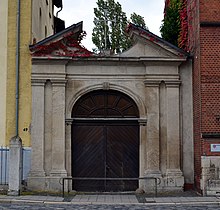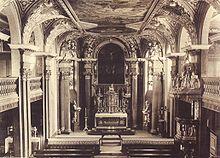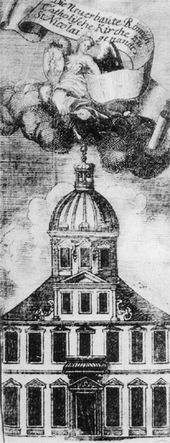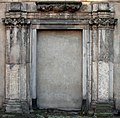St. Nicolai (Braunschweig)
St. Nicolai was a Catholic church and one of the most important baroque buildings in Braunschweig . It was completely destroyed in World War II. The church, built in the 18th century by Hermann Korb and Count Damian Hugo von Schönenborn, was located in a backyard on Friesenstrasse, today it is the schoolyard of the Catholic elementary school Edith Stein. A preserved gate portal still reminds of the destroyed church at this point. After the destruction of the Nicolaikirche, the Catholic community received the Aegidienkirche on the Aegidienmarkt as a new place of worship.
history
The half - timbered church, built from 1710 to 1712 by Hermann Korb and Count Damian Hugo von Schönborn and facing south, was located on Friesenstrasse in the Weichbild Altewiek and also housed the community school and the parish apartment. Against the resistance of the Braunschweig clergy, it was commissioned and donated by Duke Anton Ulrich ; This was in 1710 to the Catholic faith to convert . The interior was painted by the court painter Tobias Querfurt († 1734) , who was also converted shortly after his employer .
Since Braunschweig converted to the Lutheran faith in 1528/31 , the Nicolai Church , consecrated to St. Nicholas in 1712, was the first Catholic church to be built in Braunschweig since the Reformation . There was also a cemetery right by the church.
In the early 20th century, the Nicolai Church was rebuilt and expanded and finally rededicated on October 17th, 1908.
The church was destroyed during the Second World War , on October 15, 1944 , during the heaviest air raid on Braunschweig, which destroyed around 90% of the medieval city center in a firestorm , and, like almost all of the buildings on Friesenstrasse, was not rebuilt.
On September 1, 1945, the Braunschweiger Aegidienkirche , which had previously been used as a museum, was handed over to the Catholic Propsteigemeinde St. Nicolai, which had lost its church building . In 1948 the first service was celebrated in the new church building. On December 8, 1979, the Nicolai parish took over the name St. Aegidien. The Catholic community gained greater importance after 1945, as many expellees from the former German eastern regions , especially from Silesia , came to Braunschweig and the number of the Catholic population increased (currently approx. 12%).
Remembrance and remembrance
Parts of the Nicolaikirche, namely the portal and some window frames, were walled into a house wall in another place in 1968, between Echternstraße and Güldenstraße , along a parking lot, where they were then until 2011. The outer version of the portal now forms the entrance gate to the schoolyard Friesenstrasse. A portal figure is located in the Aegidienkirche .
Due to the planned development of the parking lot, the facade elements had to move from their previous location. The Braunschweig West Park was proposed as a new location . They are currently not open to the public.
Furthermore, the name of a Catholic scout group reminds of the church.
In the course of the redesign of the area around Friesenstrasse, a square that was created in 2007 along Friesenstrasse, in the immediate vicinity of the former location of the church, was to be named "Nicolaiplatz" in memory of it. The square was eventually named St. Nicolai Square .
architecture

The entrance to the church was decorated with Ionic pilasters, above which there was a figure of St. Nicholas in a niche between the sculptures of Faith and Hope. The front part (northern part) of the building was intended as living space for the clergy and consisted of two floors. Inside was a painting of the Ascension of Christ above the entrance.
The ceiling of the church interior was supported by Roman free-standing wall pillars and formed a mirror vault covered with wood . This mirror vault was painted with frescoes . In the middle was a picture of the Trinity , to the right and left of it pictures from the Old and New Testaments.
The choir room was equipped with a high altar with several figures, above was a large painting of the crucifixion of Jesus, as well as a picture of the dying Saint Nicholas and a picture of the fall of the angels. Around the altar there were four free-standing Roman columns on top of which six angel figures were placed. Life-size wooden figures of the apostles Peter and Paul were placed between the columns.
Furnishing
The Nicolaikirche had several liturgical vessels and vestments. Some of the vestments were even given by Maria Theresa of Austria . The vessels included: 1) a silver monstrance with gold-plated decorations, 2) a silver, completely gold-plated ciborium, 3) two silver altar candlesticks with figures, 4) a silver censer with silver chains, boat and spoon, 5) a silver sacrificial plate, 6) two pairs of silver gilded measuring jugs with plates, 7) a silver, completely gilded goblet with paten and spoon and four other goblets and a silver communion goblet, 8) a column with silver and gilded decoration given in 1814 by Duke Friedrich Wilhelm.
Hochstrasse community cemetery
The cemetery of the Nicolai community is located in Hochstraße directly next to the water tower on the Giersberg , but has not been used since 1901, when the water tower was built. During the Nazi era , it was used between November 1942 and the end of 1944 to bury Catholic prisoners of war, forced laborers and babies. The cemetery fell into disrepair until 1994, when it was finally converted into a memorial for the victims of National Socialism on a German-Polish initiative around the year 2000.
Leftovers
Remnants of the base of a figure of Nicholas above the portal, inscription: S. NI (COLAUS) ECCL (ESIAE) PATRON (US), St. Nicholas, patron of this church
Capital of the right portal pilaster with the head of an angel
literature
- Wilhelm August Gottlieb Assmann : The city of Braunschweig. A historical-topographical handbook for locals and foreigners. , Brunswick 1841.
- Wolfgang A. Jünke: Destroyed art from Braunschweig's churches - inner city churches and chapels before and after 1944. Groß Oesingen 1994, pp. 242–255.
- Catholic Propstei-Pfarramt St. Nicolai, Braunschweig (Ed.): 250 years of the Catholic parish of Braunschweig 1708–1958. Braunschweig 1958.
- Wolfgang Kimpflinger: Monuments in Lower Saxony. Volume 1.1 .: City of Braunschweig. Part 1 (= monument topography Federal Republic of Germany ). Hameln 1993, ISBN 3-87585-252-4 , pp. 163-164.
- Paul Jonas Meier , Karl Steinacker : The architectural and art monuments of the city of Braunschweig. 2nd, expanded edition. Braunschweig 1926, pp. 37, 93.
- Museum in Wolfenbüttel Castle, Department of Building History of the TU Braunschweig (Ed.): Hermann Korb and his time. Baroque building in the Principality of Braunschweig-Wolfenbüttel. Appelhans, Braunschweig 2006, ISBN 978-393766451-4 , p. 163f.
- Philip Christian Ribbentrop : Description of the city of Braunschweig. First volume, Johann Christoph Meyer, Braunschweig 1789, pp. 129–131.
- Christof Römer , Ute Römer-Johannsen: 800 years of St. Aegidien. Liebfrauenmünster of the Catholic Propsteigemeinde St. Nicolai in Braunschweig. (= Publications of the Braunschweigisches Landesmuseum. 22, ISSN 0174-660X ). Catholic Propsteipfarramt St. Nicolai, Braunschweig 1979.
Web links
- History of the church on the website of the Association for History and Art in the Diocese of Hildesheim eV
- Historical photographs of the Nikolaikirche Braunschweig on Bildindex.de , accessed on February 23, 2014
Coordinates: 52 ° 15 ′ 51.4 ″ N , 10 ° 31 ′ 48.5 ″ E






